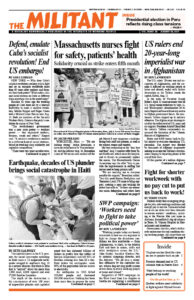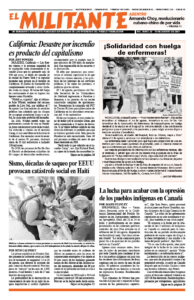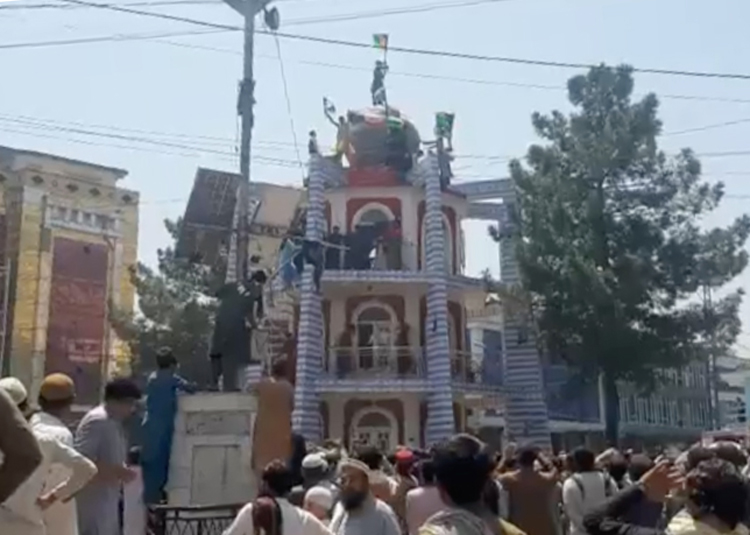The U.S. rulers’ 20-year war and occupation of Afghanistan, and the carnage it inflicted on working people at home and abroad, ended with further devastation as the Taliban retook the capital, Kabul, Aug. 15.
In the wake of President Joseph Biden’s April 13 announcement that all U.S. forces would withdraw by Sept. 11, and Washington’s abandonment of its main Bagram airbase without any notice to Afghan government forces, the reactionary Taliban stepped up its military offensive. The Afghan army disintegrated after the withdrawal of U.S. army and air support. President Ashraf Ghani fled the country. Taliban commanders announced the formation of the “Islamic Emirate of Afghanistan.”
Biden sent 6,000 troops back to Kabul airport to evacuate remaining U.S. personnel. The airport was flooded by thousands of Afghanis desperately seeking to escape the Taliban’s clutches, some clinging to departing planes at the cost of their lives.
Of the quarter of a million Afghans who fled ahead of the Taliban advance, 80% are women and girls, fearing a repeat of the brutal assault on women’s rights enforced during the Taliban’s previous time in power.
A Taliban spokesman claims the group has changed, and has announced a general amnesty and won’t interfere in people’s lives if they maintain the ways of Islam. However, there are reports of civilians being brutalized and captured soldiers executed, and of young women forced into marriages with Taliban fighters. Some towns were looted.
In some areas local Taliban commanders are imposing harsh restrictions on social and cultural activity. They have closed girls’ schools and pressured young men to take up arms for them. Young people listening to music have been punished.
A small protest by women in Kabul Aug. 17 called on the Taliban to stop trying to “eliminate women” from public life.
Hundreds took to the streets of Jalalabad and Khost Aug. 18 protesting Taliban rule. In Jalalabad, Taliban soldiers fired into the crowd killing two and injuring a dozen.
“Throughout the war the Socialist Workers Party has demanded the unconditional withdrawal of all U.S. forces from Afghanistan,” Dennis Richter, the SWP’s candidate for California governor, told the Militant. “The destruction Washington has wreaked in Afghanistan for 20 years is further reason to demand it halt its intervention elsewhere, and for working people here to build a movement to take power out of the hands of the capitalist warmakers.”
War devastated working people
The U.S. rulers’ Afghan war was launched by President George W. Bush after the 9/11 attack on the World Trade Center and Pentagon by al-Qaeda, which the Taliban allowed free range in Afghanistan. The war has cost the lives of over 47,000 civilians and 66,000 Afghan soldiers as well as more than 3,500 U.S. and allied troops. Hundreds of thousands have been displaced internally, with millions more fleeing, especially to neighboring Pakistan and Iran.
Successive U.S. governments claimed the war was needed to prevent another 9/11 attack on the U.S. Throughout its occupation of Afghanistan, Washington fostered the illusion that its foreign policy is “ours,” lumping the millions of workers and farmers exploited by the ruling capitalist families and used as cannon fodder in their wars with the exploiting classes and their servants in the government, press and academia.
In fact, the carnage and dispossession of millions resulting from the war was a consequence of the U.S. rulers’ ceaseless drive to maximize their profits and extend their domination worldwide. Washington’s display of military might in Afghanistan and Iraq was meant to assert its supremacy against rivals and force governments that stood in its way to submit. Both wars were fought under the illusion that the U.S. rulers had won the Cold War and could impose their sway as they wished.
In the course of both conflicts successive Democratic and Republican governments stepped up attacks on political rights at home in the name of advancing their “war on terror.” They expanded phone, email and internet surveillance; tracking of financial transactions; snooping on passenger lists of airlines and other transportation; and spying on political groups and individuals who opposed Washington’s policies.
They also used the war in Afghanistan to extend the reach of their military bases and operations into Central Asia.
The forces that became the Taliban emerged after the 1979 invasion of Afghanistan by the Soviet Union, which aimed to bolster the Stalinist-led People’s Democratic Party of Afghanistan government that came to power during a popular revolution the year before.
1978 popular revolution
That revolution awakened the hopes of millions of toilers in one of the most economically underdeveloped countries in the world. The PDPA government legalized unions, canceled peasants’ debts to landlords, allowed oppressed nationalities to publish and broadcast in their own languages for the first time and promised to distribute land to peasants.
But the regime looked to Moscow and treated peasants and workers as objects to be administered, as opposed to leading the toilers to become actors in history, defend their interests and take greater control over their lives. It became increasingly isolated.
Moscow sent an invading force to prop up the PDPA government and orchestrated the brutal murder of one wing of its leadership. The U.S. rulers backed a reactionary rebellion of landlord and Islamist forces against the Moscow-dependent PDPA. These forces spawned both the Taliban and al-Qaeda. Moscow was eventually forced to withdraw its troops after a 10-year occupation, which had become increasingly unpopular at home. Its defeat in Afghanistan fueled revulsion toward the regime in Moscow, contributing to the collapse of the Soviet Union in 1991.
After years of conflict between rival warlords, the Taliban swept to power in 1996. It enforced reactionary political and cultural conditions on working people. Public beheadings, amputations and stonings were typical of its despotic rule.


